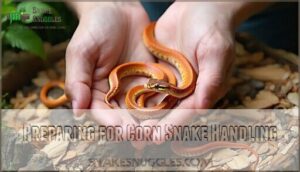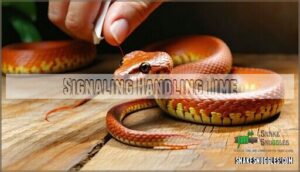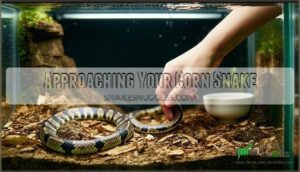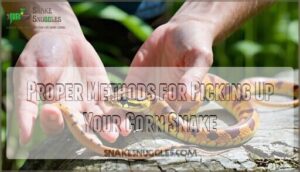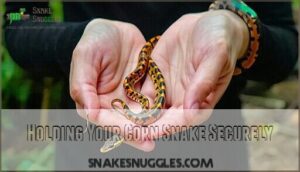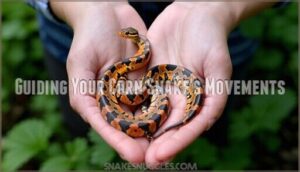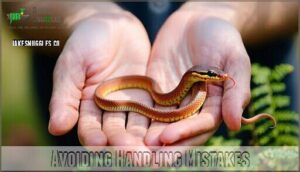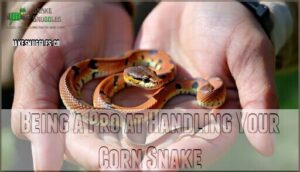This site is supported by our readers. We may earn a commission, at no cost to you, if you purchase through links.
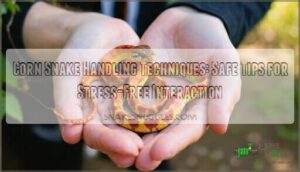
Always let your snake get comfy in its environment first; a relaxed snake is a happy one.
When it’s time, approach slowly from the side (never from above; you don’t want to mimic a predator). Gently scoop from below, supporting its body.
Hold firmly but not too tight—think handshake, not a squeeze! Let your snake explore while guiding its movements.
Avoid handling after meals or during shedding, as that’s like interrupting someone mid-snack. The better your technique, the more your snake will enjoy the interaction, and remember to handle with care!
Table Of Contents
- Key Takeaways
- Preparing for Corn Snake Handling
- Picking Up Your Corn Snake Safely
- Handling Your Corn Snake Properly
- Avoiding Handling Mistakes
- Being a Pro at Handling Your Corn Snake
- Frequently Asked Questions (FAQs)
- How long does it take to handle a corn snake?
- Can a corn snake handle a No-No?
- Should you handle a corn snake after a meal?
- How do you handle a corn snake?
- How do you handle a snake?
- How do you stop a corn snake from being scared?
- How to properly handle a corn snake?
- How do corn snakes like to be held?
- Are corn snakes easy to handle?
- How to tell if your corn snake is happy?
- Conclusion
Key Takeaways
- Always support your corn snake’s body fully and avoid grabbing its head or tail to help it feel secure.
- Handle gently and stay calm, moving slowly to build trust and prevent stress.
- Avoid handling right after feeding or during shedding to ensure your snake’s comfort and health.
- Watch for signs of calm behavior like smooth movements and regular feeding to know your snake is ready for handling.
Preparing for Corn Snake Handling
Before handling your corn snake, it’s important to give it time to adjust to its new home and routine.
Rushing this step could make your snake stressed and you, well, less popular with your scaly friend.
Acclimating Your New Pet Corn Snake
Bringing home a corn snake? Start with a smooth acclimation period to minimize stress.
Set up its terrarium like a comfy retreat:
- Initial Setup: Add hiding spots for security and regulate temperatures.
- Observation Period: Avoid handling while monitoring behavior.
- First Feeding: Wait a few days before offering food.
This time helps build confidence and trust. Remember, gentle handling begins later, allowing your snake to adjust to its new environment comfortably.
Choosing The Right Time for Handling
Knowing when to handle your corn snake is critical for its well-being.
Timing affects your snake’s comfort and stress levels.
For example, never handle shortly after feeding, as it needs 48 hours to digest—regurgitation risk isn’t worth it!
Steer clear during shedding; impaired vision makes them cranky.
Here’s a quick guide:
| Condition | Action | Why |
|---|---|---|
| Right after feeding | Avoid | Regurgitation risk |
| During shedding cycle | Avoid | Impaired vision |
| Calm and relaxed | Perfect time | Best mood for handling |
| Feeling stressed | Avoid | Prevent unnecessary stress |
Before handling, always remember to wash your hands to avoid scent confusion.
Know your snake’s behavior—happy snakes equal happy handlers!
Recognizing Signs of Acclimation
Spotting when your corn snake is ready to handle takes a bit of observation and patience. Signs like eating regularly, showing calm behavior, and exploring its enclosure without stress are green flags. You’ll also notice normal shedding cycles and a reduction in defensive movements.
Eating well, staying calm, and exploring stress-free? These are your corn snake’s green lights for handling!
Look for these signs during the acclimation period:
- Eating habits: Regular meals show your snake is adjusting.
- Calm postures: A relaxed snake isn’t overly tense or coiled.
- Exploration signs: Active but not frantic movements indicate comfort.
- Shedding cycles: Clear, complete sheds signal good health.
Rushing snake handling can cause stress, so let your pet lead the pace. Patience really does pay off!
Picking Up Your Corn Snake Safely
When it’s time to pick up your corn snake, approach it calmly and with confidence to avoid startling it.
Using gentle, steady movements, you’ll guarantee the experience is safe and stress-free for both you and your slithery companion.
Signaling Handling Time
Before handling your corn snake, start with gentle pre-handling signals.
A light tap on its body with a paper towel roll tells your snake it’s time to interact—without confusing your hand for food.
Observe its snake body language; a calm, relaxed snake is ready, while rapid movements suggest stress.
Keep your movements smooth and quiet to avoid startling it.
Positive reinforcement matters—handle regularly but stick to a consistent routine.
Gradual introduction builds trust, making handling enjoyable for both of you.
Remember, your calm approach influences your snake’s behavior, and positive reinforcement is key to a successful interaction, ensuring a relaxed snake.
Approaching Your Corn Snake
Approaching your corn snake requires patience and confidence. A calm approach sets the tone for safe and stress-free interaction.
Always use a side approach to avoid startling the snake, as coming from above may trigger defensive behavior. Gentle tapping with a snake hook can signal your presence without overwhelming it.
Create a secure environment by minimizing loud noises or sudden movements. Move slowly and deliberately, showing the snake you’re not a threat.
- Respect its boundaries by pausing if it retreats.
- Use positive reinforcement by staying calm.
- Observe body language to gauge stress levels, ensuring a stress-free interaction.
Proper Methods for Picking Up Your Corn Snake
When it’s time to pick up your corn snake, start with a calm approach. Gently tap its back with a snake hook to signal handling time.
Use safe scooping—slide your hand under its body, supporting most of its length. Avoid grabbing or restraint, especially near the head.
Let the snake explore as you practice gentle handling and follow basic snake handling guidelines. A corn snake hook can aid in safely initiating contact.
Smooth, steady movements are key to mastering safe snake handling techniques!
Handling Your Corn Snake Properly
When handling your corn snake, it’s important to keep it secure while allowing natural movements.
Think of it as guiding a curious ribbon—gentle support prevents stress and keeps both of you safe.
Holding Your Corn Snake Securely
Holding your corn snake securely is all about balance and finesse. Think of it as carrying something precious but not fragile—firm, not forceful.
Use these tips to perfect your technique:
- Secure Grip: Use both hands for full-body support, not just your fingers, to avoid drops.
- Body Support: Always cradle your snake’s midsection; this keeps it relaxed and comfortable.
- Gentle Guidance: Maintain calm movements and avoid squeezing, as snakes respond better to soft, confident handling.
Remember to wash your hands to avoid scent confusion issues. Perfecting these methods fosters trust.
Guiding Your Corn Snake’s Movements
Guide your corn snake’s movements with gentle guidance and steady body support.
Hold its middle securely while allowing it to glide freely through your hands. Avoid sudden shifts or tight restraint—it’s a trust, not a tug-of-war!
Use slow, confident motions, letting the snake explore at its own pace. A relaxed snake signals you’re doing it right.
Snake handling techniques like these build confidence for both of you, turning gentle handling into a calming, shared experience.
Allowing Exploration and Climbing
A corn snake’s love for climbing makes exploring your arms and shoulders a delightful activity.
Create Safe Climbing Spaces by ensuring your Handling Environment is secure. Allow Supervised Exploration, letting it slither naturally while you support its body.
By encouraging Natural Behaviors, you provide Enrichment Opportunities that keep your snake happy. Consider adding arboreal enrichment options to their habitat.
Just avoid wobbly surfaces—no snake acrobatics here! These snake handling techniques also strengthen your bond and showcase your corn snake’s curious and active behavior.
Avoiding Handling Mistakes
Handling mistakes can stress your corn snake, making interactions unpleasant for both of you.
Handling mishaps can upset your snake—stay calm and patient to turn every interaction into a stress-free experience.
By learning what to avoid, you’ll keep your slithery friend comfortable and healthy—nobody likes a hangry or cranky snake!
Handling After Feeding
After a meal, your corn snake needs downtime to digest properly. Think about how you’d feel after a big dinner—your snake’s no different. Handling too soon can lead to regurgitation and stress.
Always wait 48 hours post-feeding to guarantee digestion goes smoothly. For information about appropriate feeding supplies, consult specialized vendors.
- Wait 48 hours before handling to prevent regurgitation.
- Observe for relaxed movements indicating digestion.
- Stick to properly sized meals.
- Minimize stress by keeping the enclosure quiet.
- Avoid handling at feeding times.
Handling During Shedding
During shedding, your corn snake might feel extra sensitive—think of it as their “bad hair day.”
Look out for shedding stress signs like cloudy eyes or dull skin—these are part of typical shedding cycle stages.
Handling during this time increases the skin damage risk, so it’s best to leave your snake alone.
Instead, focus on keeping its humidity and habitat ideal.
For handling alternatives, use this period to observe their behavior or clean the enclosure.
Post-shed handling is safer and guarantees a stress-free interaction for both of you.
Handling When Your Corn Snake Feels Threatened
When your corn snake feels threatened, it’s showing clear defensive behaviors. Recognizing stress can prevent issues like biting or injury.
Here’s how to handle it safely:
- Recognize stress cues – Watch for an “S” posture, fast tongue flicks, or jerky moves.
- Stay patient – Calm movements build trust.
- Avoid provoking bites – Approach from the side, giving your snake a safe retreat option.
Building trust takes time. Remember to wash your hands to avoid scent confusion issues.
Being a Pro at Handling Your Corn Snake
Mastering the art of handling your corn snake takes time, patience, and consistency.
By starting with short sessions and staying calm, you’ll build trust with your slithery friend while keeping stress to a minimum.
Starting With Short Handling Sessions
When starting with your corn snake, keep those first sessions short—think 5 to 10 minutes. Like meeting a shy friend, you want to build trust slowly.
Frequency matters, so aim for gentle handling sessions 1-2 times a day, depending on the snake’s comfort. Watch for relaxed body posture and calm tongue flicks, as these are signs of ease.
Gradual increase is key—don’t rush. Use positive reinforcement by only returning the snake when it’s calm.
Gentle handling techniques, like supporting its entire body, make a big difference. Remember, handling tips include avoiding sudden movements and letting the snake explore. It’s all about trust and patience, with a focus on creating a calm environment through gentle handling.
Gradually Increasing Handling Time
Getting confident with longer handling sessions involves gradual steps and patience.
- Session Length: Start with 5-minute interactions and increase slowly.
- Handling Frequency: Try 1-2 times weekly to build trust.
- Snake Comfort: Watch for calm, relaxed behavior—fidgeting means it’s time to stop.
- Positive Reinforcement: Always return your snake when it’s calm, not stressed.
These handling techniques improve bonding, ensuring your corn snake feels safe while avoiding overhandling!
Being Patient and Calm During Handling
When handling your corn snake, a gentle approach with a calm demeanor works wonders.
Patience isn’t just a virtue—it’s how you earn your snake’s trust. Watch for cues like tight coiling or rapid movements—these signals mean it needs space.
Building trust takes time, but it pays off with smoother interactions. Stay calm, avoid sudden moves, and let your snake explore freely.
These handling techniques reduce stress and make every session more enjoyable. Their docile nature means they’re among the easiest snakes to handle.
Frequently Asked Questions (FAQs)
How long does it take to handle a corn snake?
It takes time and patience.
Start handling your corn snake after a two-week acclimation.
Begin with 5-minute sessions, gradually increasing to 15-30 minutes as trust builds.
Regular, gentle handling helps your snake feel at ease.
Can a corn snake handle a No-No?
No-No" moments with a corn snake are rare if you’re careful.
But if you mean handling stress, follow the basics: avoid just-fed, shedding, or cranky snakes.
Treat them gently, and they’ll stay chill.
Should you handle a corn snake after a meal?
You shouldn’t handle a corn snake right after it eats.
Give it 48 hours to digest; otherwise, it might regurgitate its meal.
Patience here saves you cleanup—and your snake from stress.
How do you handle a corn snake?
Don’t worry—they’re not slimy!
Approach your corn snake calmly from the side, scoop it gently with both hands, and support its body fully.
Avoid sudden movements, and let it explore comfortably at its own pace, this will help it feel secure and allow you to support its needs better.
How do you handle a snake?
Approach calmly from the side, then gently scoop the snake’s mid-body with both hands.
Support its entire length, avoiding sudden movements.
Let it explore at its pace, keeping it close to your body for comfort.
How do you stop a corn snake from being scared?
Help your corn snake feel safe by moving slowly, supporting its body fully, and handling it gently.
Avoid loud noises, sudden movements, or grabbing it.
Let it explore at its pace to build trust.
How to properly handle a corn snake?
Think of handling a corn snake like gaining a shy friend’s trust.
Move calmly, support its body, and avoid sudden grabs.
Let it explore at its own pace to build comfort and confidence.
How do corn snakes like to be held?
Corn snakes prefer being held with gentle, full-body support.
Let them explore at their pace, keeping your movements slow and steady.
Avoid holding their head or tail—they’ll love the comfort of feeling secure and unstressed.
Are corn snakes easy to handle?
Handling a corn snake is like holding a living ribbon—they’re flexible, calm, and surprisingly easy to manage.
With gentle handling and patience, they quickly adapt to human interaction, making them ideal for beginners.
How to tell if your corn snake is happy?
Your corn snake is happy if it explores its enclosure, feeds regularly, and doesn’t coil or move defensively during handling.
A calm, curious snake with smooth movements is a great sign it’s thriving.
Conclusion
Did you know that corn snakes can live up to 20 years with proper care?
Mastering corn snake handling techniques guarantees your pet thrives while strengthening your bond. Always approach gently, support its body, and let it explore at its own pace.
Avoid handling during shedding or right after meals to keep your snake comfy. With patience and consistent practice, you’ll become a pro at stress-free handling.
Remember, a calm handler equals a relaxed, happy snake!
- https://www.youtube.com/c/LoriTorriniAnimalBehavior
- https://www.reptifiles.com/corn-snake-care-guide/corn-snake-diseases-health/corn-snake-shedding/
- https://reptifiles.com/corn-snake-care-guide/corn-snake-handling-body-language/
- https://www.quora.com/How-long-does-it-take-for-a-corn-snake-to-get-used-to-being-handled

